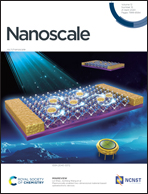A two-step gas/liquid strategy for the production of N-doped defect-rich transition metal dichalcogenide nanosheets and their antibacterial applications†
Abstract
Herein, we developed a general two-step gas expansion and exfoliation strategy based on a urea-assisted hydrothermal process combined with sonication exfoliation for the production of nitrogen (N)-doped plus defect-rich transition metal dichalcogenide (TMD) nanosheets (NSs) such as N–MoS2 and N–WS2 NSs. The interlayers of bulk MoS2 (or WS2) were expanded with urea molecules dissolved in distilled water, which were decomposed to NH3 during the hydrothermal process. Simultaneously, sulfur atoms were partly replaced by N atoms to achieve N doping. Subsequently, sonication exfoliation of the urea-treated bulk MoS2 (or WS2) promoted the production of defect-rich NSs. Importantly, the defect-rich N–MoS2 and N–WS2 NSs exhibit enhanced peroxidase-like catalytic activity after being captured by bacteria, and can catalyze hydrogen peroxide (H2O2) to produce more toxic hydroxyl radicals (˙OH) than non-N-doped MoS2 or WS2 NSs. As a result, the N–MoS2 or N–WS2 NSs were capable of effectively killing Gram-negative ampicillin resistant Escherichia coli (AmprE. coli) and Gram-positive endospore-forming Bacillus subtilis (B. subtilis) and promoting bacteria-infected wound healing. This work not only provides a simple, universal exfoliation strategy for producing defect-rich N-doped TMD NSs but also provides a promising catalytic antibacterial option and has potential for many other catalytic applications.



 Please wait while we load your content...
Please wait while we load your content...